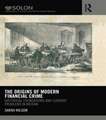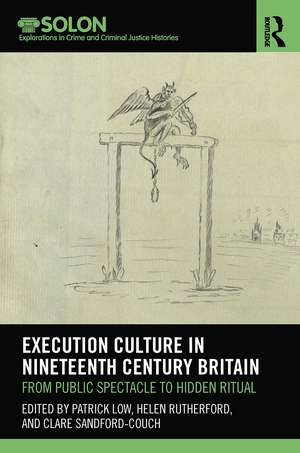Execution Culture in Nineteenth Century Britain: From Public Spectacle to Hidden Ritual: Routledge SOLON Explorations in Crime and Criminal Justice Histories
Editat de Patrick Low, Helen Rutherford, Clare Sandford-Couchen Limba Engleză Paperback – 30 mai 2022
From Public Spectacle to Hidden Ritual has two parts. Part 1 addresses the criminal body and the witnessing of executions in the nineteenth century, including studies of the execution crowd and executioners’ memoirs, as well as reflections on the experience of narratives around capital punishment in museums in the present day. Part 2 explores the treatment of the execution experience in the print media, from the nineteenth and into the twentieth century.
The collection draws together contributions from the fields of Heritage and Museum Studies, History, Law, Legal History and Literary Studies, to shed new light on execution culture in nineteenth century Britain. This volume will be of interest to students and academics in the fields of criminology, heritage and museum studies, history, law, legal history, medical humanities and socio-legal studies.
| Toate formatele și edițiile | Preț | Express |
|---|---|---|
| Paperback (1) | 311.41 lei 3-5 săpt. | +22.67 lei 7-11 zile |
| Taylor & Francis – 30 mai 2022 | 311.41 lei 3-5 săpt. | +22.67 lei 7-11 zile |
| Hardback (1) | 999.51 lei 6-8 săpt. | |
| Taylor & Francis – 30 noi 2020 | 999.51 lei 6-8 săpt. |
Din seria Routledge SOLON Explorations in Crime and Criminal Justice Histories
-
 Preț: 332.70 lei
Preț: 332.70 lei -
 Preț: 326.49 lei
Preț: 326.49 lei -
 Preț: 310.95 lei
Preț: 310.95 lei -
 Preț: 466.88 lei
Preț: 466.88 lei -
 Preț: 411.42 lei
Preț: 411.42 lei -
 Preț: 436.14 lei
Preț: 436.14 lei -
 Preț: 449.41 lei
Preț: 449.41 lei -
 Preț: 341.55 lei
Preț: 341.55 lei -
 Preț: 432.12 lei
Preț: 432.12 lei - 23%
 Preț: 351.68 lei
Preț: 351.68 lei -
 Preț: 388.42 lei
Preț: 388.42 lei -
 Preț: 387.91 lei
Preț: 387.91 lei -
 Preț: 371.30 lei
Preț: 371.30 lei -
 Preț: 382.86 lei
Preț: 382.86 lei -
 Preț: 385.71 lei
Preț: 385.71 lei -
 Preț: 383.17 lei
Preț: 383.17 lei -
 Preț: 349.71 lei
Preț: 349.71 lei -
 Preț: 389.66 lei
Preț: 389.66 lei -
 Preț: 389.66 lei
Preț: 389.66 lei - 18%
 Preț: 1116.38 lei
Preț: 1116.38 lei
Preț: 311.41 lei
Nou
Puncte Express: 467
Preț estimativ în valută:
59.59€ • 62.50$ • 49.61£
59.59€ • 62.50$ • 49.61£
Carte disponibilă
Livrare economică 11-25 martie
Livrare express 25 februarie-01 martie pentru 32.66 lei
Preluare comenzi: 021 569.72.76
Specificații
ISBN-13: 9780367521462
ISBN-10: 0367521466
Pagini: 218
Ilustrații: 9 Halftones, black and white; 9 Illustrations, black and white
Dimensiuni: 156 x 234 x 16 mm
Greutate: 0.45 kg
Ediția:1
Editura: Taylor & Francis
Colecția Routledge
Seria Routledge SOLON Explorations in Crime and Criminal Justice Histories
Locul publicării:Oxford, United Kingdom
ISBN-10: 0367521466
Pagini: 218
Ilustrații: 9 Halftones, black and white; 9 Illustrations, black and white
Dimensiuni: 156 x 234 x 16 mm
Greutate: 0.45 kg
Ediția:1
Editura: Taylor & Francis
Colecția Routledge
Seria Routledge SOLON Explorations in Crime and Criminal Justice Histories
Locul publicării:Oxford, United Kingdom
Public țintă
PostgraduateCuprins
Introduction
Chapter 1, ‘[T]he broken stave at the top of the ladder of England’s civilisation’: Representing the ending of public execution in 1868.
James Gregory
PART 1: Going to See a Man Hanged:
Chapter 2, ‘A practice which wounds only the living’: Publicly Punishing the Criminal Body in Nineteenth-Century Scotland.
Rachel Bennett
Chapter 3, ‘Every Loathsome Reptile Form of Vice and Crime’. Formulations of the Nineteenth-Century London Execution Crowd: Fears, Fictions and Realities.
Matthew White
Chapter 4, ‘How Murderers Die’: The Impact of the 1868 Abolition of Public Execution on Life-writing by Executioners.
Katherine Ebury
Chapter 5, ‘Stand in the place of those executed’: Interpreting Capital Punishment in UK Prison Museums.
Rhiannon Pickin
PART 2: ‘One had better narrate the circumstances as they occurred’
Chapter 6, ‘[…] were sensation our object, it would not be difficult to cull from the Newgate Calendar’: Periodical Journalism and Distaste for Public Executions, c. 1830-1870.
Samuel Saunders
Chapter 7, George Vass: the making and un-making of a criminal monster.
Helen Rutherford and Clare Sandford-Couch
Chapter 8, The ‘Hermetically sealed’ Prison: Witnessing Executions in the North East of England 1868-1878.
Patrick Low
Chapter 9, The only consolation is that the criminal is not a Welshman: The foreign-born men hanged in Wales, 1840-1900.
Stephanie Emma Brown
Index
Chapter 1, ‘[T]he broken stave at the top of the ladder of England’s civilisation’: Representing the ending of public execution in 1868.
James Gregory
PART 1: Going to See a Man Hanged:
Chapter 2, ‘A practice which wounds only the living’: Publicly Punishing the Criminal Body in Nineteenth-Century Scotland.
Rachel Bennett
Chapter 3, ‘Every Loathsome Reptile Form of Vice and Crime’. Formulations of the Nineteenth-Century London Execution Crowd: Fears, Fictions and Realities.
Matthew White
Chapter 4, ‘How Murderers Die’: The Impact of the 1868 Abolition of Public Execution on Life-writing by Executioners.
Katherine Ebury
Chapter 5, ‘Stand in the place of those executed’: Interpreting Capital Punishment in UK Prison Museums.
Rhiannon Pickin
PART 2: ‘One had better narrate the circumstances as they occurred’
Chapter 6, ‘[…] were sensation our object, it would not be difficult to cull from the Newgate Calendar’: Periodical Journalism and Distaste for Public Executions, c. 1830-1870.
Samuel Saunders
Chapter 7, George Vass: the making and un-making of a criminal monster.
Helen Rutherford and Clare Sandford-Couch
Chapter 8, The ‘Hermetically sealed’ Prison: Witnessing Executions in the North East of England 1868-1878.
Patrick Low
Chapter 9, The only consolation is that the criminal is not a Welshman: The foreign-born men hanged in Wales, 1840-1900.
Stephanie Emma Brown
Index
Notă biografică
Helen Rutherford is a Solicitor and Senior Lecturer in the Law School at Northumbria University. She is also in the final stages of PhD research at Newcastle University. She has published on legal education, legal history and the English Legal System. Her research interests focus on the life and work of the Victorian Coroner for Newcastle upon Tyne and nineteenth-century crime and punishment with a North East England focus.
Clare Sandford-Couch is a Visiting Lecturer in the Law School at Newcastle University. She practiced as a solicitor and was Senior Lecturer in law at Northumbria University for a number of years. She received her PhD in Art History from the University of Edinburgh in 2014. She has published on legal history, art history and the role of the arts and humanities in legal education. Her research interests largely address interactions of law and visual culture, and late medieval Italian art history. Her current research focus includes crime histories in nineteenth century Newcastle upon Tyne.
Patrick Low is an independent researcher and freelance TV historian (regular contributor to BBC One’s Murder, Mystery and My Family). He received his PhD from the University of Sunderland in 2019; his thesis examined capital punishment in the North East of England between 1800-1878 and its attendant post-mortem punishments from 1752-1878. He created the Wellcome Trust and University of Leicester’s website Harnessing the Power of the Criminal Corpse and presents ongoing research on his blog.
Clare Sandford-Couch is a Visiting Lecturer in the Law School at Newcastle University. She practiced as a solicitor and was Senior Lecturer in law at Northumbria University for a number of years. She received her PhD in Art History from the University of Edinburgh in 2014. She has published on legal history, art history and the role of the arts and humanities in legal education. Her research interests largely address interactions of law and visual culture, and late medieval Italian art history. Her current research focus includes crime histories in nineteenth century Newcastle upon Tyne.
Patrick Low is an independent researcher and freelance TV historian (regular contributor to BBC One’s Murder, Mystery and My Family). He received his PhD from the University of Sunderland in 2019; his thesis examined capital punishment in the North East of England between 1800-1878 and its attendant post-mortem punishments from 1752-1878. He created the Wellcome Trust and University of Leicester’s website Harnessing the Power of the Criminal Corpse and presents ongoing research on his blog.
Recenzii
'Execution Culture offers a series of intriguing case studies in the ways that an absence becomes present in a culture.'
- Michael Meranze, University of California, Los Angeles
- Michael Meranze, University of California, Los Angeles
Descriere
This edited collection offers multi-disciplinary reflections and analysis on a variety of themes centred on nineteenth century executions in the UK, many specifically related to the fundamental change in capital punishment culture as the execution moved from the public arena to behind the prison wall.
